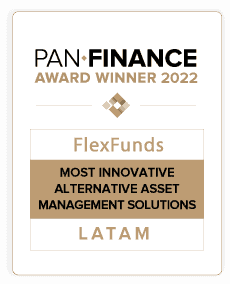- In this article, you will learn how investing in FIBRAs allows to diversify portfolios by reducing volatility.
- This information is especially relevant for fund managers and advisors who can use FIBRAs to build long-term investment strategies.
- FlexFunds enables the transformation of assets like FIBRAs into exchange-traded products (ETPs).
How asset managers can use FIBRAS to reduce portfolio volatility?
To achieve success when investing in financial markets over the long term, it’s not necessary to always have the highest-yielding assets in a portfolio. Instead, it’s important to adopt a diversification strategy.
Proper diversification involves including a sensible variety of assets and strategies, among which one can invest in FIBRAs.
Why diversifying a portfolio is important?
Before delving into the concept and functioning of FIBRAs, it’s essential to understand why diversifying an investment portfolio is recommended.
Diversification limits exposure to significant losses in the market, although it may also reduce the potential for some gains, simultaneously decreasing overall volatility.
During times when the market is performing well, a diversified investor may not enjoy all the benefits. Still, they will be protected if the bullish trend reverses and assets begin to lose value.
BlackRock, the world’s largest asset manager, explains, “…diversification can be disappointing when returns aren’t maximized during market upswings, but it’s important to have a protective mechanism during downturns. Financial professionals should prepare for a recession rather than worry about avoiding one.”
How investing in FIBRAS enhances diversification?
According to various sources, to achieve effective diversification, one must venture beyond the universe of stocks and bonds and explore other alternatives like FIBRAs.
FIBRAs, or Real Estate Investment Trusts (REITs), are companies that own and typically operate income-generating real estate assets through rents and/or appreciation.
These assets can include office buildings, shopping centers, multi-family housing, hotels, resorts, warehouses, and even mortgages or loans tied to the real estate sector.
As explained by the U.S. Securities and Exchange Commission (SEC), “REITs (FIBRAs) provide a way for individual investors to earn a share of the income produced through commercial real estate ownership without having to go out and buy commercial real estate.”
Alternative assets enhance portfolio diversification because they are typically not 100% correlated or inversely correlated with stocks and bonds. Investing in FIBRAs can be a form of diversification strategy.
According to the National Association of Real Estate Investment Trusts (NAREIT), from 1972 to 2021 (the last year for which records are available), the S&P 500 yielded an annual total return of 10.7%, while the REIT index grew by an annual total return of 11.9%.
The risks of investing in FIBRAs
Nevertheless, despite their potential to enhance portfolio diversification, investing in FIBRAs has risks.
In some cases, FIBRAs or REITs may not be as liquid as stocks, bonds, or even some commodities. This can pose challenges when attempting to sell holdings or achieve a desired price.
Additionally, if the FIBRAs in question do not trade on the secondary market, they may not be as transparent regarding the value of their shares, as they typically do not provide estimates until a year and a half after their offering closes.
In specific cases, investing in FIBRAs may involve conflicts of interest. For example, the vehicle may pay high fees to external managers based on the amount of property acquisitions, fees that may not align with the interests of investors.
In any case, besides FIBRAs, fund managers and advisors can expand and streamline the distribution of their investment strategies, providing efficient access to international investors through FlexFunds’ Flex Private Program.
The Flex Private Program is supported by reliable service providers, allowing for the launch of a real estate exchange-traded product (ETP) with its own ISIN/CUSIP code for trading on Euroclear.
If you want to learn more about exchange-listed products and how you can benefit from them, don’t hesitate to contact our team.
Sources:
- https://www.blackrock.com/americas-offshore/en/education/portfolio-construction/diversifying-investments
- https://www.investor.gov/introduction-investing/investing-basics/investment-products/real-estate-investment-trusts-reits
- https://www.fool.com/research/reits-vs-stocks/







